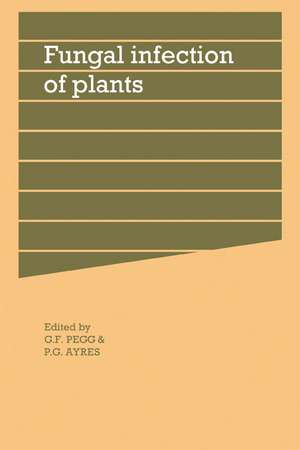Fungal Infection of Plants: Symposium of the British Mycological Society: British Mycological Society Symposia, cartea 13
Editat de G. F. Pegg, Peter G. Ayresen Limba Engleză Paperback – 8 iun 2011
Din seria British Mycological Society Symposia
- 11%
 Preț: 440.78 lei
Preț: 440.78 lei -
 Preț: 382.99 lei
Preț: 382.99 lei -
 Preț: 404.68 lei
Preț: 404.68 lei -
 Preț: 320.55 lei
Preț: 320.55 lei - 14%
 Preț: 782.83 lei
Preț: 782.83 lei - 11%
 Preț: 532.53 lei
Preț: 532.53 lei - 11%
 Preț: 435.33 lei
Preț: 435.33 lei - 14%
 Preț: 767.64 lei
Preț: 767.64 lei -
 Preț: 357.89 lei
Preț: 357.89 lei -
 Preț: 416.98 lei
Preț: 416.98 lei -
 Preț: 427.94 lei
Preț: 427.94 lei -
 Preț: 323.56 lei
Preț: 323.56 lei - 11%
 Preț: 472.83 lei
Preț: 472.83 lei - 11%
 Preț: 478.08 lei
Preț: 478.08 lei - 11%
 Preț: 676.05 lei
Preț: 676.05 lei -
 Preț: 398.54 lei
Preț: 398.54 lei -
 Preț: 354.25 lei
Preț: 354.25 lei -
 Preț: 268.13 lei
Preț: 268.13 lei - 11%
 Preț: 438.40 lei
Preț: 438.40 lei
Preț: 434.12 lei
Nou
Puncte Express: 651
Preț estimativ în valută:
83.08€ • 86.24$ • 69.27£
83.08€ • 86.24$ • 69.27£
Carte tipărită la comandă
Livrare economică 24 martie-07 aprilie
Preluare comenzi: 021 569.72.76
Specificații
ISBN-13: 9780521106283
ISBN-10: 0521106281
Pagini: 444
Dimensiuni: 152 x 229 x 25 mm
Greutate: 0.65 kg
Editura: Cambridge University Press
Colecția Cambridge University Press
Seria British Mycological Society Symposia
Locul publicării:Cambridge, United Kingdom
ISBN-10: 0521106281
Pagini: 444
Dimensiuni: 152 x 229 x 25 mm
Greutate: 0.65 kg
Editura: Cambridge University Press
Colecția Cambridge University Press
Seria British Mycological Society Symposia
Locul publicării:Cambridge, United Kingdom
Cuprins
List of contributors; Preface; 1. Specificity of active resistance mechanisms in plant–fungus interactions J. J. G. M. De Wit; 2. Specificity and recognition in ectomycorrhizal associations J. A. Duddridge; 3. Spores on leaves: endogenous and exogenous control of development John Lucas and Ian Knights; 4. Pathways for the exchange of materials in mycoparasitic and plant–fungal interactions Peter Jeffries; 5. Induced modifications in the plasma membranes of infected cells J. L. Gay and A. M. Woods; 6. Nutrient relations in biotrophic infections J. F. Farrar and D. H. Lewis; 7. Some aspects of fungal enzymes that degrade cell walls J. P. R. Keon , R. J. W. Bryde and R. M. Cooper; 8. The role of fungal toxins in plant disease Herman W. Knoche and Jonathan P. Duvick; 9. Antifungal substances from herbaceous plants Paul J. Kuhn and John A. Hargreaves; 10. Antimicrobial defences in secondary tissues of woody plants R. B. Pearce; 11. Comparisons between vesicular-arbuscular mycorrhizal fungi with respect to the development of infection and consequent effects on plant growth S. Al-Nahidh and F. E. Sanders; 12. Fruiting and successions of ectomycorrhizal fungi P. A. Mason, F. T. Last, J. Wilson, J. W. Deacon, L. V. Fleming and F. M. Fox; 13. Formation and dispersal of propagules of endogonaceous fungi Christopher Walker; 14. Programmed cortical senescence: a basis for understanding root infection J. W. Deacon; 15. The role of the saptophytic phase in Dutch elm disease Joan F. Webber, C. M. Brasier and A. G. Mitchell; 16. Sporulation of foliar pathogens Y. Cohen and J. Rotem; 17. Double-stranded RNA viruses of pathogenic fungi: virulence and plant protection Yigal Koltin, Aliza Finkler and Bat-Sheba Ben-Zvi; 18. Inoculum production and survival infungi which form sclerotia A. R. Entwhistle; 19. Genetic analysis of interactions between microbes and plants Albert H. Ellingboe; 20. Immunisation against disease: the plant fights back Ralph A. Dean and Joseph A. Kuć; Index
Descriere
This 1987 book examines infection as a phenomenon common to pathogenic and mycorrhizal fungi alike.










